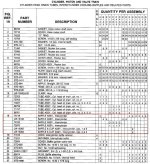Mconner7
Well Known Member
I am still suffering fairly hot CHT’s on my recently (35 hours) rebuilt O-540. On trip yesterday at 5000’ I tried to run 75% (172 KTAS) but had to run 17 gph to keep #6 below 400 degrees. At 21”/2300 I can get the ff down to 11 gph at 160 knots and be at 385 CHT.
I read this from Savvy Aviation but I don’t think our Lycoming inter cylinder baffles are location specific?
https://mailchi.mp/savvyaviation.co...Mw3xO-d1EpBxDvdRh50rDEmy5AhMXO0_9dcW-ztScFEh4
I read this from Savvy Aviation but I don’t think our Lycoming inter cylinder baffles are location specific?
https://mailchi.mp/savvyaviation.co...Mw3xO-d1EpBxDvdRh50rDEmy5AhMXO0_9dcW-ztScFEh4
Last edited:





